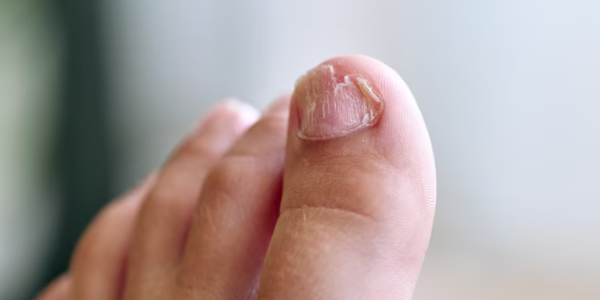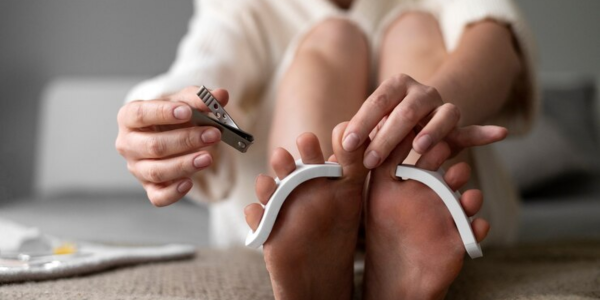How to Get Rid of Stubborn Toenail Fungus
How to Get Rid of Stubborn Toenail Fungus: The Ultimate Guide

Toenail fungus is a common, frustrating condition that can make you feel self-conscious and uncomfortable.
Whether you’re dealing with discolored, thickened nails or an unpleasant odor, toenail fungus can be a persistent problem that doesn’t always go away on its own.
But with the right approach, you can get rid of stubborn toenail fungus and restore your nails to their healthy, natural state.
In this comprehensive guide, we’ll explore everything you need to know about treating toenail fungus, from the causes and symptoms to the most effective treatments.
What Is Toenail Fungus?
Toenail fungus, also known as onychomycosis, is an infection caused by fungi that thrive in warm, moist environments.
This condition often begins as a small white or yellow spot under the tip of the toenail but can progressively worsen if left untreated.
The infection can spread deeper into the nail, causing it to become thick, brittle, discolored, and in some cases, even painful.
Toenail fungus is highly contagious and can spread from one toe to another or from person to person. It’s particularly common in people who frequently expose their feet to damp, dark environments, like public showers, swimming pools, or gyms.
The Causes of Toenail Fungus
Toenail fungus develops when fungi enter the nail through small cuts or breaks in the skin. Once inside, they begin to grow and multiply, creating an infection. There are several factors that increase your risk of developing toenail fungus:
- Warm and Moist Environments: Fungi thrive in warm, damp places. If your feet sweat a lot or you wear shoes that trap moisture, you’re more likely to develop toenail fungus.
- Poor Foot Hygiene: Not washing your feet regularly or not drying them properly after washing can create the perfect breeding ground for fungi.
- Nail Trauma: If your toenail is injured, it can create an opening for the fungus to enter.
- Age: Older adults tend to have slower-growing nails and reduced circulation, making them more vulnerable to fungal infections.
- Weakened Immune System: Individuals with conditions such as diabetes or those undergoing chemotherapy may have a weaker immune system, which makes it harder for the body to fight off infections like toenail fungus.
- Shared Spaces: Fungi can spread in communal spaces such as gyms, pools, and locker rooms, especially if people walk barefoot in these areas.
Signs and Symptoms of Toenail Fungus
Toenail fungus doesn’t always cause noticeable symptoms right away, but as the infection worsens, you may notice:
- Discoloration: The toenail may turn white, yellow, brown, or even green.
- Thickening: The nail becomes thicker and more difficult to trim.
- Brittle or Crumbling Nail: The toenail may become brittle, cracked, or crumble away.
- Odor: Foul-smelling odor may emanate from the infected toenail.
- Pain: In severe cases, toenail fungus can cause pain or tenderness, especially when pressure is applied to the affected toe.
- Distortion of the Nail Shape: The nail may become distorted or lose its smooth, shiny appearance.
If you notice any of these symptoms, it’s important to seek treatment early to prevent the infection from spreading or worsening.

How to Get Rid of Stubborn Toenail Fungus: Effective Treatment Options?
Toenail fungus can be stubborn and difficult to treat, but with the right approach, you can eliminate the infection and restore the health of your toenails. Here are some of the most effective treatment options available:
1. Topical Antifungal Treatments
Topical antifungal treatments are often the first line of defense against toenail fungus. These treatments come in various forms, including creams, ointments, gels, and lacquers.
They work by applying an antifungal medication directly to the affected toenail. Common over-the-counter topical antifungal treatments include:
- Lotrimin (Clotrimazole)
- Lamisil (Terbinafine)
- Mentax (Miconazole)
Topical treatments can help clear up mild to moderate cases of toenail fungus, but they are less effective for severe infections or when the fungus has penetrated deep into the nail.
For optimal results, it’s important to apply these treatments as directed and continue using them for several weeks or even months.
2. Oral Antifungal Medications
In cases of severe toenail fungus, or when topical treatments aren’t effective, oral antifungal medications may be necessary.
These medications work by attacking the fungal infection from the inside out, helping to eliminate the fungus throughout the body. Common oral antifungal medications include:
- Terbinafine (Lamisil)
- Itraconazole (Sporanox)
- Fluconazole (Diflucan)
Oral medications typically require a prescription from a healthcare provider and can have side effects, such as liver damage or interactions with other medications.
For this reason, it’s important to follow your healthcare provider’s instructions and monitor for any potential side effects during treatment.
3. Laser Treatment for Toenail Fungus
Laser therapy is an increasingly popular treatment option for toenail fungus. The procedure uses focused light to target and kill the fungi that are causing the infection.
The laser penetrates the nail and the underlying tissue, destroying the fungus without damaging surrounding healthy tissue. While laser treatments can be effective, they are often not covered by insurance and may require multiple sessions for optimal results.
4. Home Remedies for Toenail Fungus
Some people prefer natural remedies to treat toenail fungus. While there is limited scientific evidence to support their effectiveness, several home treatments may help manage mild cases of toenail fungus. Here are some popular home remedies:
- Tea Tree Oil: Tea tree oil has natural antifungal properties and is often used to treat toenail fungus. Apply a few drops of diluted tea tree oil directly to the affected nail twice daily.
- Vicks VapoRub: This common household remedy contains camphor and eucalyptus oil, both of which may help treat fungal infections. Apply a small amount to the affected nail daily.
- Apple Cider Vinegar: Apple cider vinegar has been used for a variety of ailments, including fungal infections. Soaking your feet in a mixture of water and apple cider vinegar may help kill the fungus.
- Garlic: Garlic contains compounds with antifungal properties. Crushed garlic cloves can be applied to the affected toenail or soaked in water to create a foot bath.
While these remedies may offer some relief, they are generally most effective when used in combination with more proven treatment methods, such as antifungal medications.
5. Proper Foot Care and Hygiene
Good foot hygiene is essential for preventing and treating toenail fungus. Keeping your feet clean and dry is one of the best ways to prevent fungal infections. Follow these tips to help maintain healthy feet:
- Wash your feet regularly: Use soap and water to wash your feet every day, paying attention to the spaces between your toes.
- Dry your feet thoroughly: Fungi thrive in moist environments, so be sure to dry your feet completely, especially between the toes, after bathing or swimming.
- Wear breathable shoes: Opt for shoes made of natural materials, such as leather or canvas, which allow air to circulate around your feet.
- Change socks regularly: Wearing socks made of moisture-wicking materials, such as wool or synthetic blends, can help keep your feet dry.
- Avoid going barefoot in public areas: Public showers, pools, and locker rooms are common places where fungi can spread. Always wear flip-flops or waterproof shoes in these areas.
6. Preventing Toenail Fungus Relapse
Toenail fungus can sometimes return, especially if you don’t take proper precautions. To reduce the risk of recurrence, consider the following:
- Finish the full course of treatment: Even if your toenail fungus appears to improve, continue treatment for the full duration to ensure that the infection is completely eliminated.
- Use antifungal powder or spray: After treatment, you can use antifungal powder or spray inside your shoes to prevent future infections.
- Trim nails regularly: Keeping your nails trimmed can help prevent injury and reduce the risk of fungal infections taking hold.
When to Seek Professional Help?
While toenail fungus can often be treated at home or with over-the-counter medications, there are times when you should seek professional help. If your infection is particularly severe, painful, or does not respond to home treatments, it’s essential to consult a healthcare provider or a podiatrist.
A doctor can provide a proper diagnosis and recommend the most effective treatment for your condition, whether that involves prescription medications, laser therapy, or other advanced treatment options.
If you have diabetes or another condition that weakens your immune system, it’s especially important to see a doctor if you suspect toenail fungus.
Conclusion
Toenail fungus may be a common condition, but it doesn’t have to be a permanent one. With the right treatment and proper care, you can get rid of stubborn toenail fungus and restore your nails to their natural, healthy state.
Whether you choose topical treatments, oral medications, laser therapy, or natural remedies, consistency and patience are key.
Remember to take preventative measures to avoid future infections, and don’t hesitate to seek professional help if needed. Your healthy, beautiful toenails are just within reach!

.